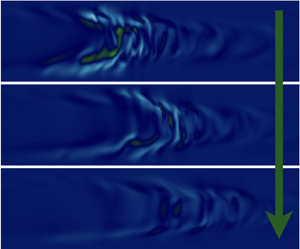Published online by Cambridge University Press: 15 February 2021

Turbulence locally created in laminar pipe flows shows sudden decay or splitting after a stochastic waiting time. In laboratory experiments, the mean waiting time was observed to increase double-exponentially as the Reynolds number ( $Re$) approaches its critical value. To understand the origin of this double-exponential increase, we perform many pipe flow direct numerical simulations of the Navier–Stokes equations, and measure the cumulative histogram of the maximum axial vorticity field over the pipe (turbulence intensity). In the domain where the turbulence intensity is not small, we observe that the histogram is well-approximated by the Gumbel extreme value distribution. The smallest turbulence intensity in this domain roughly corresponds to the transition value between the locally stable turbulence and a metastable (edge) state. Studying the
$Re$) approaches its critical value. To understand the origin of this double-exponential increase, we perform many pipe flow direct numerical simulations of the Navier–Stokes equations, and measure the cumulative histogram of the maximum axial vorticity field over the pipe (turbulence intensity). In the domain where the turbulence intensity is not small, we observe that the histogram is well-approximated by the Gumbel extreme value distribution. The smallest turbulence intensity in this domain roughly corresponds to the transition value between the locally stable turbulence and a metastable (edge) state. Studying the  $Re$ dependence of the fitting parameters in this distribution, we derive that the time scale of the transition between these two states increases double-exponentially as
$Re$ dependence of the fitting parameters in this distribution, we derive that the time scale of the transition between these two states increases double-exponentially as  $Re$ approaches its critical value. On the contrary, in smaller turbulence intensities below this domain, we observe that the distribution is not sensible to the change of
$Re$ approaches its critical value. On the contrary, in smaller turbulence intensities below this domain, we observe that the distribution is not sensible to the change of  $Re$. This means that the decay time of the metastable state (to the laminar state) is stochastic but
$Re$. This means that the decay time of the metastable state (to the laminar state) is stochastic but  $Re$-independent in average. Our observation suggests that the conjecture made by Goldenfeld et al. to derive the double-exponential increase of turbulence decay time is approximately satisfied in the range of
$Re$-independent in average. Our observation suggests that the conjecture made by Goldenfeld et al. to derive the double-exponential increase of turbulence decay time is approximately satisfied in the range of  $Re$ we studied. We also discuss using another extreme value distribution, Fréchet distribution, instead of the Gumbel distribution to approximate the histogram of the turbulence intensify, which reveals interesting perspectives.
$Re$ we studied. We also discuss using another extreme value distribution, Fréchet distribution, instead of the Gumbel distribution to approximate the histogram of the turbulence intensify, which reveals interesting perspectives.